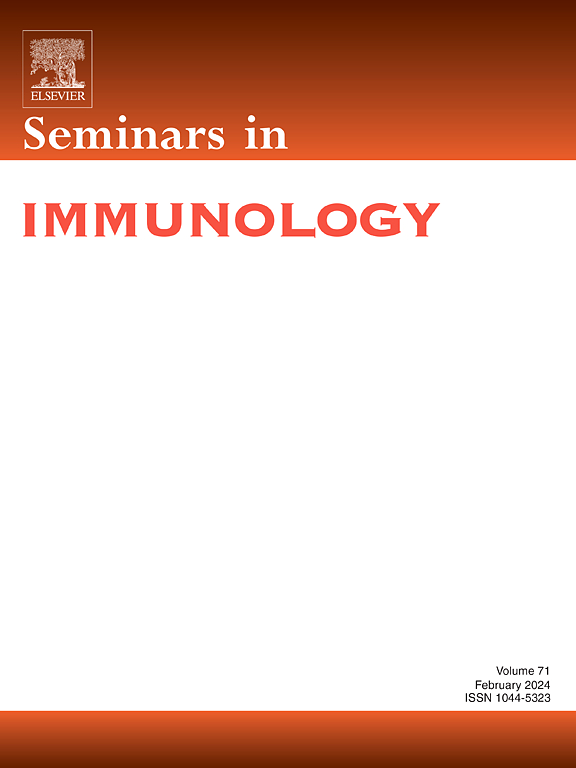不同乳糜泻表现背后的免疫反应差异
IF 7.8
2区 医学
Q1 IMMUNOLOGY
引用次数: 0
摘要
在乳糜泻(CeD)中,膳食麸质是小肠黏膜免疫反应的驱动因素,这种免疫反应通常导致小肠黏膜绒毛萎缩和隐窝增生,同时伴有疾病特异性的转谷氨酰胺酶2 (TG2)靶向自身抗体反应。TG2自身抗体阳性但小肠黏膜形态正常的个体被认为是发生CeD的风险增加,并代表潜在的CeD患者。在大多数情况下,从饮食中去除麸质会导致自身抗体的消失和粘膜结构的正常化。然而,难治性CeD患者偏离了这一教条,因为他们表现出异常的T细胞室,持续的症状和绒毛萎缩,尽管严格的无麸质饮食。由于不同的症状,CeD表现的异质性进一步多样化。胃肠道症状是CeD最典型的症状,包括腹泻、呕吐、便秘和腹痛。然而,很大一部分患者的疾病表现在肠外部位,如皮肤、肌肉骨骼系统或神经组织。除了各种转谷氨酰胺酶自身抗体的参与之外,促成这些表现发展的详细免疫机制仍然难以捉摸。本文综述了目前对CeD各种表现的免疫学差异的认识。由于目前对不同CeD表型的免疫学基础了解不足,在这些数据能够最大限度地应用于临床实践之前,需要对该主题进行更多的研究。本文章由计算机程序翻译,如有差异,请以英文原文为准。
Differential immune responses behind different celiac disease manifestations
In celiac disease (CeD), dietary gluten serves as the driver for a comparatively well characterized small bowel mucosal immune response that generally results in small bowel mucosal villous atrophy and crypt hyperplasia along with a disease-specific transglutaminase 2 (TG2) targeting autoantibody response. Individuals with positive TG2 autoantibodies but normal small intestinal mucosal morphology are regarded at increased risk of developing CeD and represent patients with potential CeD. The removal of gluten from the diet leads to disappearance of the autoantibodies and normalization of the mucosal architecture in most cases. However, refractory CeD patients deviate from this dogma as they present with abnormal T cell compartment, persistent symptoms and villous atrophy despite a strict gluten-free diet. The heterogeneity of CeD presentation is further diversified by varying symptomatology. Gastrointestinal symptoms are the most canonical signs of CeD, and they include for instance diarrhea, vomiting, constipation and abdominal pain. Yet, a great portion of the patients manifest the disease at extraintestinal sites such as skin, musculoskeletal system or neuronal tissues. Beyond the involvement of various transglutaminase autoantibodies, the detailed immune mechanisms contributing to the development of these manifestations remains elusive, though. This review highlights the current understanding of the immunological differences in various manifestations of CeD. As the immunological basis of the different CeD phenotypes is at present insufficiently understood, more research on the subject is warranted before such data could be maximally applied to clinical practice.
求助全文
通过发布文献求助,成功后即可免费获取论文全文。
去求助
来源期刊

Seminars in Immunology
医学-免疫学
CiteScore
11.40
自引率
1.30%
发文量
50
审稿时长
89 days
期刊介绍:
Seminars in Immunology is a specialized review journal that serves as a valuable resource for scientists in the field of immunology. The journal's approach is thematic, with each issue dedicated to a specific topic of significant interest to immunologists. It covers a wide range of research areas, from the molecular and cellular foundations of the immune response to the potential for its manipulation, highlighting recent advancements in these areas.
Each thematic issue is curated by a guest editor, who is recognized as an expert in the field internationally. The content of each issue typically includes six to eight authoritative invited reviews, which delve into various aspects of the chosen topic. The goal of these reviews is to provide a comprehensive, coherent, and engaging overview of the subject matter, ensuring that the information is presented in a timely manner to maintain its relevance.
The journal's commitment to quality and timeliness is further supported by its inclusion in the Scopus database, which is a leading abstract and citation database of peer-reviewed literature. Being indexed in Scopus helps to ensure that the journal's content is accessible to a broad audience of researchers and professionals in immunology and related fields.
 求助内容:
求助内容: 应助结果提醒方式:
应助结果提醒方式:


